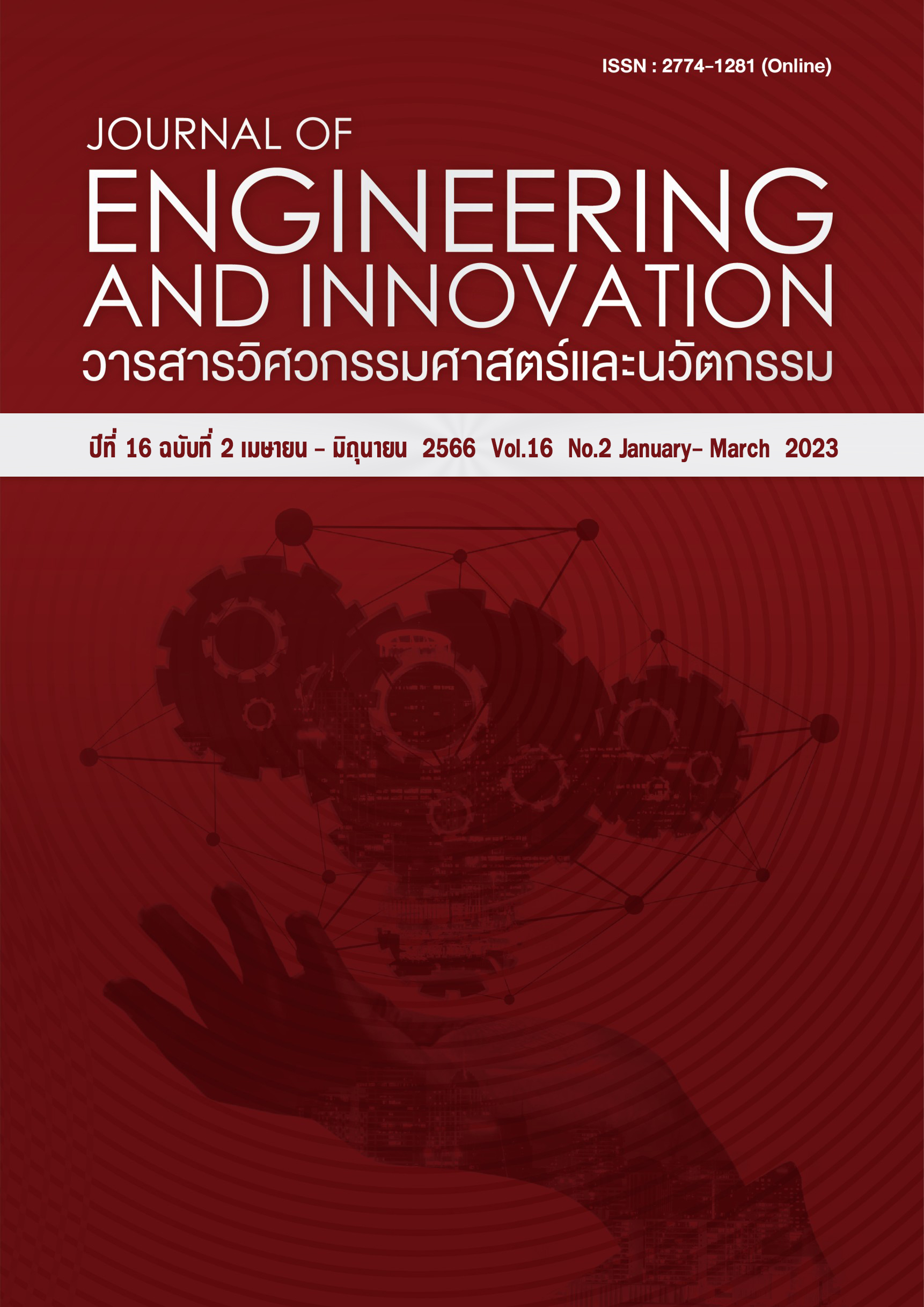Effect of silica reinforcing agent treated with admicellar polymerization technique on the mechanical properties and ozone resistance of natural rubber
Main Article Content
Abstract
This article investigated the effect of adding admicellar polymerized silica (modified silica) as a reinforcement filler on mechanical properties and ozone resistance of natural rubber. In this study, the modified silica was added to 300 grams natural rubber with different ratio ranging from 20 to 50 phr (Parts Per Hundred of Rubber). The reinforced rubber specimens were formed by compression molding at a 145 °C. Later, the specimen were undergone mechanical tests and the ozone resistant test to obtain tensile strength, tear strength, hardness, and ozone aging resistance. The results revealed that the reinforced rubber with 40 phr modified silica that was cured for 138.23 ± 1.06 s exhibited the best mechanical properties and ozone aging resistance. The tensile strength, the 300% modulus, the tear strength, the elongation at break, and the Shore A hardness of the 40 phr specimen were 21.55 ± 0.40 MPa, 4.62 ± 0.17 MPa, 73.67 ± 1.58 MPa, 579.96 ± 6.70%, and 55.33 ± 1.15, respectively.
Article Details
References
Rubber Research Institute Department of Agriculture. (2021). Statistical of the Thai Rubber 377 Association Database. Search for information on 10 June 2021. http://www.thainr.com/uploadfile/20200427101016.pdf
M. P. Wagner, “Reinforcing silicas and silicates,” Rubber Chemistry and Technology, vol. 49, no.3, pp.703-774, 1976.
พงษ์ธร แซ่อุย ,2548, ยาง: ชนิด สมบัติ และการใช้งาน, ศูนย์เทคโนโลยีโลหะและวัสดุแห่งชาติ (เอ็มเทค), พิมพ์ครั้งที่ 2, หน้า 11-15.
พงษ์ธร แซ่อุย, 2548, สารเคมียาง, ศูนย์เทคโนโลยี โลหะและวัสดุแห่งชาติ (เอ็มเทค), พิมพ์ครั้งที่ 2, หน้า 70-74.
S. Kim, et al., “Surface Modification of Silica Nanoparticles by UV-Induced Graft Polymerization of Methyl Methacrylate,” Journal of Colloid and Interface Science, vol. 292, no.1, pp. 93-98, 2005.
J. Che, et al., “Graft Polymerization onto Nano-Sized SiO2 Surface and its Application to the Modification of PBT,” Journal of Materials Letters, vol.59, pp.1603-1609, 2005.
B. J. Jeon, H.J.Hah and S.M. Koo, “Surface Modification of Silica Particles with Organoalkoxysilance Through Two-step (acid-base) Process in Aqueous Solution,” Journal of Ceramic Processing Research, vol. 3, no.3, pp. 216-221, 2002.
Wu, J.H., Harwell, J.H. & O’Rear, E.A. (1987). Two-dimensional solvents: kinetics of styrene polymerization in admicelles at or near saturation. The Journal of Physical Chemical. Vol. 91, No. 3, pp. 623-634
Thammathadanukul, V., O’Haver, J.H., Harwell, J.H., Osuwan, S., Na-Ranong, N. & Waddell, W.H. (1996). Comparison of rubber reinforcement using various surface modified silica. Journal of Applied Polymer Science. Vol. 59, pp. 1741-1750
Nontasorn, P., Chavadej, S., Rangsunvigit, P., O’Haver, J.H., Chaisirimahamorakot, S. & Na- Ranong, N. (2005). Admicellar polymerization modified silica via a continuous stirred tank reactor system: comparative properties of rubber compounding. Chemical Engineering Journal. Vol. 108, pp. 213-218
Kitiyanan, B., O’Haver, J.H., Harwell, J.H. & Osuwan, S. (1996). Adsolubilization of styrene and isoprene into cetyltrimethyl ammonium bromide admicelle on precipitated silica. Langmuir. Vol. 12, pp. 2162-2168
Yooprasert, N., Pongprayoon, T., Suwanmala, P., Hemvichian, K. & Tumcharern, G. (2010). Radiation induced admicellar polymerization of isoprene on silica: effects of surfactant’s chain length. Chemical Engineering Journal. Vol. 156, pp. 193-199
Pongprayoon, T., Yooprasert, N., Suwanmala, P., Hemvichian, K. (2012). Rubber products prepared from silica modified by radiation-induced admicellar polymerization. Radiation Physics and Chemistry Journal. Vol. 81, pp. 541-546

